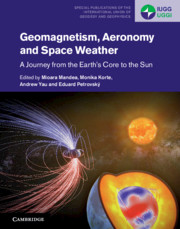Book contents
- Geomagnetism, Aeronomy and Space Weather
- Special Publications of the International Union of Geodesy and Geophysics Series
- Geomagnetism, Aeronomy and Space Weather
- Copyright page
- Contents
- Contributors
- Preface
- Part I Introduction
- 1 Objectives of Geomagnetic and Aeronomy Studies
- 2 Why Study the Geomagnetic Field?
- 3 Major Scientific Contributions of the International Association of Geomagnetism and Aeronomy (IAGA) during the Past 100 Years
- Part II Geomagnetic Field
- Part III Spatial and Temporal Variations of the Geomagnetic Field
- Part IV Space Weather
- Part V Magnetic Fields beyond the Earth and beyond Today
- Index
- References
3 - Major Scientific Contributions of the International Association of Geomagnetism and Aeronomy (IAGA) during the Past 100 Years
from Part I - Introduction
Published online by Cambridge University Press: 25 October 2019
- Geomagnetism, Aeronomy and Space Weather
- Special Publications of the International Union of Geodesy and Geophysics Series
- Geomagnetism, Aeronomy and Space Weather
- Copyright page
- Contents
- Contributors
- Preface
- Part I Introduction
- 1 Objectives of Geomagnetic and Aeronomy Studies
- 2 Why Study the Geomagnetic Field?
- 3 Major Scientific Contributions of the International Association of Geomagnetism and Aeronomy (IAGA) during the Past 100 Years
- Part II Geomagnetic Field
- Part III Spatial and Temporal Variations of the Geomagnetic Field
- Part IV Space Weather
- Part V Magnetic Fields beyond the Earth and beyond Today
- Index
- References
Summary
We review the progress in geomagnetic research for the century preceding the founding of IAGA’s predecessor in 1919. We then discuss the contributions of IAGA to the development of the study of geomagnetism and aeronomy during the past 100 years, as illustrated by the marked expansion in the number and geographic coverage of magnetic observatories. IAGA has led efforts to develop geomagnetic indices, reference fields, magnetic anomaly maps, and to rapidly distribute magnetic data. It played a key role in the establishment of aeronomy as a separate scientific discipline. IAGA has fostered the coordination of paleomagnetic data bases and was an early advocate of the investigation of Sun-Earth relationships. IAGA flagship efforts since 1919 years include support to the highly-successful International Geophysical Year (IGY) in 1957–1958 and more recently to the IGY 50th-year commemorative programs of the International Heliophysical Year (IHY) and Electronic Geophysical Year (eGY).
Keywords
- Type
- Chapter
- Information
- Geomagnetism, Aeronomy and Space WeatherA Journey from the Earth's Core to the Sun, pp. 30 - 38Publisher: Cambridge University PressPrint publication year: 2019



